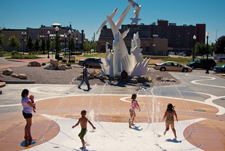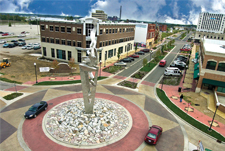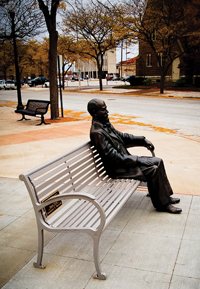By Jennifer Kriscunas
Location: Muskegon, Michigan
Population: 38,401
The “Lumber Queen of the World,” as Muskegon was known in the late 1800s, needed to re-imagine its future for the 21st century and allow the community to reconnect to its downtown roots. The city began to develop a vision for downtown that not only looked at the property, but what the property could be, and how it would be connected to other components within the core city. According to City Manager Bryon Mazade, “We had to find a way to get control of the properties that were chained off and boarded up in order to implement the vision of the community.”
 |
 |
Imagine Muskegon
In cooperation with the city in 2002, the Community Foundation for Muskegon County, the Muskegon Area Chamber of Commerce, and the Paul C. Johnson Foundation formed the Downtown Muskegon Development Corporation (DMDC). The DMDC purchased the vacant mall area with the intention of facilitating the redevelopment of a new, revitalized central business district. They removed the chains around the parking lots and made them available for community use again, which begged the question—what now?
The formation of the DMDC encouraged several different groups within the community to interact and provided a financial vehicle for enacting the renewal process. The DMDC and members of the community came together to share ideas of what they envisioned for their downtown. This public visioning workshop, named “Imagine Muskegon,” identified two major needs:
1) A need to create dynamic, social public spaces in an inviting urban context to attract people to the downtown area; and
2) A need to create a sense of place with enhanced circulation and the inclusion of relevant public art, community identity elements, and outdoor event/performance areas.
Concepts were developed in a second, more detailed study by Fleis & VandenBrink Engineering (F&V) to envision a downtown Muskegon which would be vibrant, community-focused, and an attraction for the community and the region. Design concepts included restoration of the original Main Street and side streets with wide, walkable sidewalks, bike facilities, on-street parking, street lights, landscaping, and plenty of street furniture.
Included within the concepts were designated areas for public art and culturally significant gathering areas and features. The DMDC recognized that putting up public art not only attracts visitors, it also encourages donors, while being a less expensive alternative to constructing a new building. Every downtown revitalization effort they studied included interactive art elements.
 |
| Arise, thou Muskegon, thou queen of the harbors, Arise in thy glory and claim thy estate; No longer thy saw mills sing loud in thy arbors, Yet echoes an anthem more sure and more great —Douglas Malloch |
Public Art is Critical to Attracting Donors
“One of the first directives of the DMDC was to create a public art committee,” recalls Chris McGuigan, Director of the Community Foundation. “This committee was given the job of creating the designs, the nice touches. We have an unbelievable art museum and we also knew that cool downtowns have art that you could interact with. Looking back, I didn’t fully appreciate—I don’t think anybody did—that including public art in your downtown attracts people and donors. People love that—it’s just more fun!”
At the heart of downtown, reaching skyward from the center of a roundabout, a stainless steel structure rises to a crown of silvery waves, wings, and an upstretched arm. The sculpture—by internationally renowned sculptor Richard Hunt—brings to life the poem that inspired the name of the sculpture, “Muskegon, Together Rising.”
Restoring the Queen
This project exemplifies a successful private/public partnership that was instrumental in bringing the “Imagine Muskegon” visions to life. While major infrastructure improvements were funded by Michigan’s Community Revitalization program, neither the city nor the DMDC had the funds to create the public spaces with benches, planters, public art, stages, and rain gardens. “Projects of this scale and diversity are only possible through many agencies and organizations of the private and public sectors working together,” said Mazade. “The community was asked to take ownership of the development of the promenade through private donations, and they delivered.”
F&V assisted in the professional design to redevelop the primary street grid, adding walkability and “safe streets” improvements. A landscaped boulevard on the main historic street and a roundabout at a principal city center intersection were incorporated into the plan. The roundabout was strategically placed adjacent to the city’s historic Frauenthal Performance Center and main hotel at Third Street. It became the focus for new development with the “Muskegon Rising” sculpture, new Chamber of Commerce headquarters, new office building, and the Baker College Culinary Institute.
The area, now known as the Third Street Commons, includes decorative concrete paving, a performance stage, outdoor seating, and an outdoor “soapbox” performance venue with a stage and site furniture. Elements like the Chamber Square Rain Garden, which collects the rainwater from the roof drains, add a functional green space to the urban design.
Another design feature in the public space for downtown was developed with children in mind. Recently completed on the former Federal Square site sits Alcoa Celebration Square. This wide public space is anchored by the relocated and restored fish, birds, and stars of “Ascension” by James Clover and framed by huge geometric, integrally colored blocks for people to sit on. The centerpiece of the square is a water park with a spray fountain that was designed with several sustainable methods, including recirculating water. It creates “white noise barriers” to surrounding noise pollution as well as natural air filters and conditioners. The square offers not only the dancing water of the fountain and the interaction of playful children, but room to roam, relax, socialize, and people-watch.
Chris McGuigan says community feedback has been positive. “So they recognize that this is a big change.” Indeed, with the combined efforts of the city, the DMDC, F&V, and local citizens, the downtown area has become a vibrant and active epicenter that continues to grow and evolve today. Like Richard Hunt’s iconic sculpture, the city of Muskegon is rising!
Jennifer Kriscunas is a marketing coordinator at Fleis & VandenBrink Engineering, Inc.
For project information, contact Fleis & VandenBrink project managers Don DeVries, PE, at 616-977-1000 or [email protected] or Harry Wierenga, RLA, at [email protected].